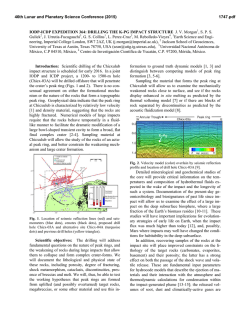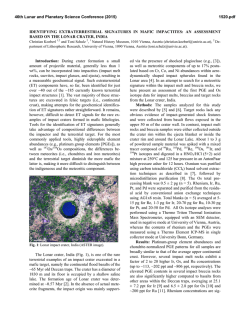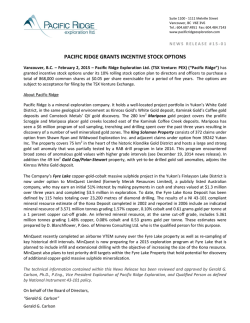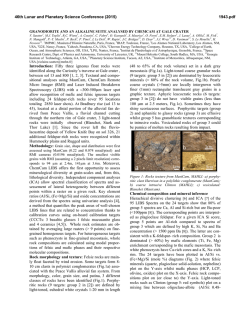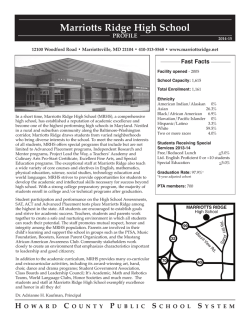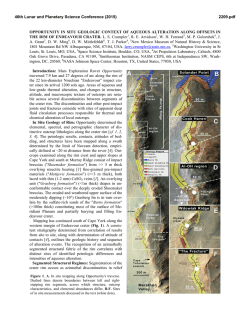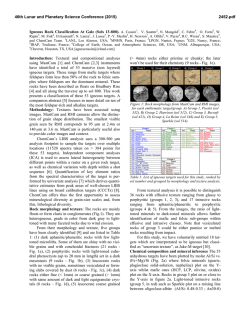
noachian impact ejecta on murray ridge and pre
46th Lunar and Planetary Science Conference (2015) 2705.pdf NOACHIAN IMPACT EJECTA ON MURRAY RIDGE AND PRE-IMPACT ROCKS ON WDOWIAK RIDGE, ENDEAVOUR CRATER, MARS: OPPORTUNITY OBSERVATIONS. D. W. Mittlefehldt1, R. Gellert2, D. W. Ming1, R. V. Morris1, C. Schröder3, A. S. Yen4, W. H. Farrand5, R. E. Arvidson6, B. J. Franklin4, J. A. Grant7, K. E. Herkenhoff8, B. L. Jolliff6 and the Athena Science Team. 1NASA/Johnson Space Center, ([email protected]), 2University of Guelph, 3University of Stirling, 4JPL/Caltech, 5Space Science Institute, 6Washington University in Saint Louis, 7Smithsonian Institution, NASM CEPS, 8U.S.G.S., Astrogeology Science Center. Introduction: Mars Exploration Rover Opportunity has been exploring Meridiani Planum since January 2004, and has completed 4227% of its primary mission. Opportunity has been investigating the geology of the rim of 22 km diameter Endeavour crater, first on the Cape York segment and now on Cape Tribulation. The outcrops are divided into three formations: (i) the lower Matijevic fm, a pre-impact lithology on Cape York; (ii) the Shoemaker fm, impact breccias representing ejecta from the crater; and (iii) the upper Grasberg fm, a post-impact deposit that drapes the lower portions of the eroded rim segments [1-3]. On the Cape Tribulation segment Opportunity has been studying the rocks on Murray Ridge, with a brief sojourn to Wdowiak Ridge west of the rim segment (Fig. 1). (The ridge is named in honor of Athena science team member Thomas Wdowiak, who died in 2013.) One region of Murray Ridge has distinctive CRISM spectral characteristics indicating the presence of a small concentration of aluminous smectite based on a 2.2 µm Al-OH combination band [4] (hereafter, the Al-OH region). Figure 1. Cape Tribulation APXS target locator map. Here we discuss the rocks of Murray Ridge and Wdowiak Ridge, focusing on comparisons between: (i) Murray Ridge rocks inside and outside the Al-OH region; and (ii) Wdowiak Ridge rocks versus those on main rim segments. Compositions were determined by the Alpha Particle X-Ray Spectrometer (APXS) and spectral characteristics were determined by Panoramic Camera (Pancam) 13-filter observations. Most of the APXS targets were not brushed or abraded. This adds some uncertainty to interpretations of rock compositions owing to the presence of dust, soil, pebbles, and possibly alteration rinds on rock surfaces. Targets with substantial lag materials on them are not discussed. Cape Tribulation: Matijevic fm rocks have not been found on Cape Tribulation. This lithology was only observed on the inboard side of Cape York, and we have not explored an equivalent region of Cape Tribulation. The rocks on Murray Ridge are breccias texturally like those on Cape York and are mapped as Shoemaker fm. Wdowiak Ridge is capped by texturally distinctive, fine-grained, homogeneous-textured dark rocks. Opportunity did not study them in situ; the APXS targets are either float (target 7; Fig. 1) or ejecta from the small crater on the SW end (area 8; Fig. 1). Many of the Wdowiak Ridge rocks have patches of darker exfoliation flakes (Fig. 2) that are remnants of materials from within fracture planes [4]. Opportunity studied a bright linear feature on the lower slope of the rim that appears to be a fracture zone (area 9; Fig. 1). Outcrop rocks in the fracture zone have hackly surfaces and are clastic, but are texturally distinct from typical Shoemaker fm breccias. A Ca-sulfate-rich vein cuts across the outcrop. Figure 2. Wdowiak Ridge rock Lipscomb showing brushed target Margaret and flake target Victory. APXS and Pancam Results: The compositions presented here have been recalculated on a volatilefree basis. Murray Ridge rocks (white and cyan spots, Fig. 1) generally have compositions within family of the Shoemaker fm targets on Cape York (Fig. 3), but there are some systematic trends with location. The northernmost target (spot 1, Fig. 1) has a very low 46th Lunar and Planetary Science Conference (2015) Fe/Mn while the southernmost targets (spot 3, Fig. 1) have high Fe/Mn (Fig. 3a). The Fe/Mn ratio can be perturbed from the primary ratio (martian meteorites, Gusev basalts), by differential mobilization of Fe and Mn by redox processes, thus these targets were altered, either in situ on Murray Ridge [5] or in the pre-impact protoliths [6]. None of the targets from the Al-OH region are close to the primary Fe/Mn ratio indicating generally greater degree of alteration of these rocks. Figure 3. Compositions of Cape Tribulation targets. Shoemaker fm field is only for Cape York targets. Wdowiak Ridge rocks have compositions that are very distinct from the Shoemaker fm (Fig. 3b). With the exception of Hoover (H), Wdowiak Ridge rocks have Fe/Mn close to the primary martian ratio (Fig. 3a). The Lipscomb Victory flake (LV) differs only slightly in composition from the Lipscomb Margaret target (LM), but does have higher Fe/Mn, which is consistent with slightly greater degree of alteration. The fracture zone targets have compositions within family of Shoemaker fm breccias for those elements least susceptible to mobilization (Fig. 3). Figure 4. Pancam 13F spectra of Lipscomb, and matrix and clast from Moreton Island (area 2; Fig. 1). 2705.pdf Pancam 13-filter spectra of Wdowiak Ridge rocks are distinctive compared to the matrix of Murray Ridge breccias, and subtly different from clasts (Fig. 4). The Fe crystal field band minimum in Lipscomb is at 904 nm, while it is at 934 nm in the Moreton Island clast. The clast also has a steeper 754 to 864 nm spectral slope than the Wdowiak Ridge rocks. Discussion: The impact process is highly chaotic, mixing pre-impact lithologies in the ejecta that forms crater rims. Thus it is not surprising that impact breccias on Cape York and Cape Tribulation are generally similar in composition. Consistent with their location within the CRISM aluminous smectite region, the APXS targets there typically have higher Fe/Mn ratios than little-altered martian igneous rocks. Their compositions suggest a greater degree of alteration than found for most Shoemaker fm rocks. Wdowiak Ridge rocks have: (i) distinctive compositions compared to rocks on the Endeavour rim; (ii) near pristine Fe/Mn ratios; and (iii) are not breccias. Further, CRISM spectra of Wdowiak Ridge have relatively deep olivine and pyroxene absorption features compared to surrounding regions [4] suggesting the rocks are less altered. One hypothesis is that Wdowiak Ridge is a small rim segment and the rocks are large clasts from within a breccia deposit. However, the abundance of unbrecciated rocks and a paucity of impact breccias on Wdowiak Ridge suggest that this is unlikely. A second hypothesis is that Wdowiak Ridge is a megablock of the target lithology lofted beyond the main rim. Megablocks of target rocks of similar size are found at the 26 km diameter Ries crater. While these are concentrated within the outer rim, blocks similar in size to Wdowiak Ridge are found up to several km outside the rim [7]. A third hypothesis is that Wdowiak Ridge represents a topographic high of the pre-impact surface. A fourth hypothesis is that the Wdowiak Ridge rocks are impact-melt material from the Endeavour impact [8]. The many fracture planes within the rocks suggests the second and third hypotheses are more plausible, and in either case, the Wdowiak Ridge rocks would represent a pre-impact lithology that is distinct from the Matijevic fm (Fig. 3b.). References: [1] Squyres S. W. et al. (2012) Science, 336, 570-576. [2] Arvidson R. E. et al. (2014) Science, 343, doi: 10.1126/science.1248097. [3] Crumpler L. S. et al. (2015) J. Geophys. Res. Planets, in revision. [4] Arvidson R. E. et al. (2015) LPS, XLVI, this conference. [5] Ming D. W. et al. (2015) LPS, XLVI, this conference. [6] Mittlefehldt D. M. et al. (2014) LPS, XLV, Abstract #1640. [7] Sturm S. et al. (2014) Meteoritics Planet. Sci., doi: 10.1111/maps.12408. [8] Grant J. A. et al. (2015) LPS, XLVI, this conference.
© Copyright 2026
